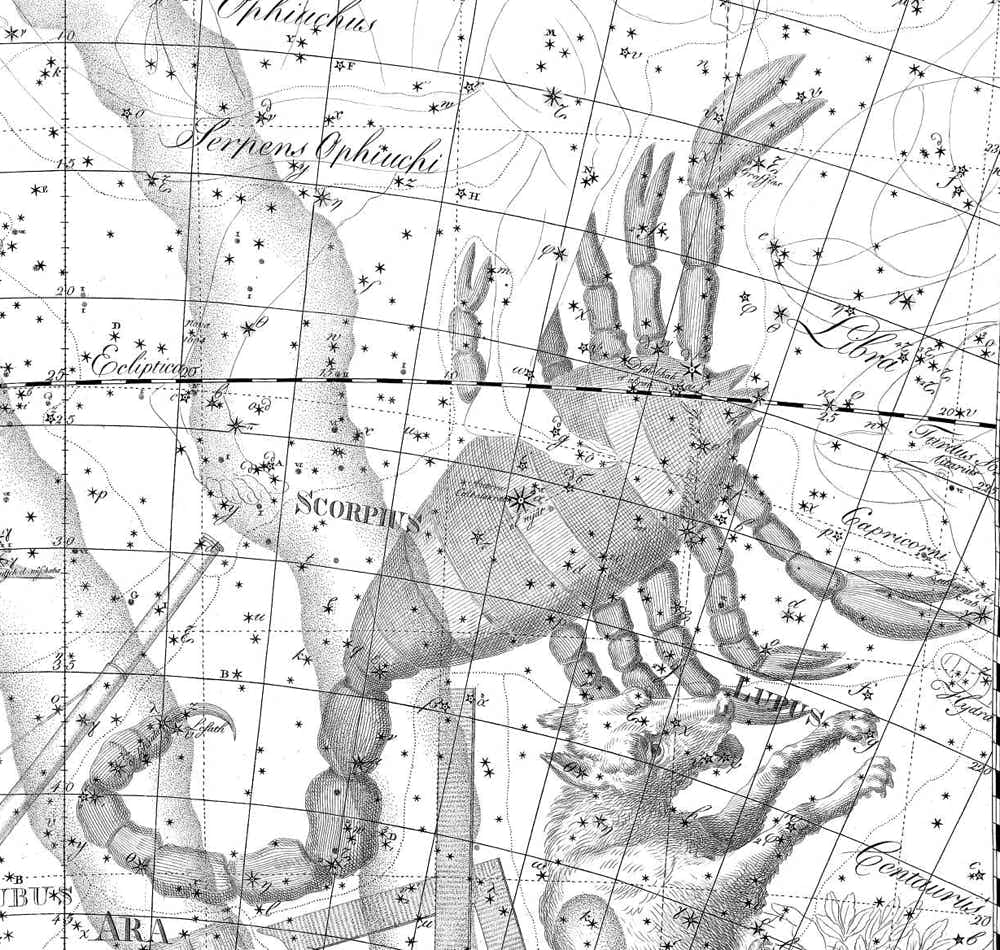
Genitive: Scorpii
Abbreviation: Sco
Size ranking: 33rd
Origin: One of the 48 Greek constellations listed by Ptolemy in the Almagest
Greek name: Σκορπίος (Skorpios)
‘There is a certain place where the scorpion with his tail and curving claws sprawls across two signs of the zodiac’, wrote Ovid in his Metamorphoses. He was referring to the ancient Greek version of Scorpius, which was much larger than the constellation we know today. The Greek scorpion was in two halves: one half, called Σκορπίος (Skorpios), contained its body and sting, while the front half comprised the claws. The Greeks called this front half Χηλαί (Chelae), which means ‘claws’. In the first century BC the Romans made the claws into a separate constellation, Libra, the balance.
In mythology, this is the scorpion that stung Orion the hunter to death, although accounts differ as to the exact circumstances. Eratosthenes offers two versions. Under his description of Scorpius he says that Orion tried to ravish Artemis, the hunting goddess, and that she sent the scorpion to sting him, an account that is supported by Aratus. But in his entry on Orion, Eratosthenes says that the Earth sent the scorpion to sting Orion after he had boasted that he could kill any wild beast. Hyginus also gives both stories. Aratus says that the death of Orion happened on the island of Chios, but Eratosthenes and Hyginus place it in Crete.
In either case, the moral is that Orion suffers retribution for his hubris. This seems to be one of the oldest of Greek myths and the origin may lie in the sky itself, since the two constellations are placed opposite each other so that Orion sets as his conqueror the scorpion rises. But the constellation is much older than the Greeks, for the Sumerians knew it as GIR-TAB, the scorpion, over 5,000 years ago.
Scorpius from Chart XV of the Uranographia of Johann Bode (1801). Part of the scorpion’s body is overlapped by the lower left leg and foot of Ophiuchus. In the middle of the scorpion’s body lies the red star Antares. On this chart, Bode also gives Antares the alternative name Calbalakrab, from the Arabic qalb al-‘aqrab meaning ‘scorpion’s heart’.
Scorpius clearly resembles a scorpion, particularly the curving line of stars that form its tail with its sting raised to strike. Old star maps show the lower left leg and foot of Ophiuchus, to the north, awkwardly overlapping the scorpion’s body. Incidentally, Scorpius is the modern astronomical name for the constellation; Scorpio is the old name, now used only by astrologers. The name in Greek was Σκορπίος, as used by Ptolemy in the Almagest.
Antares and the stars of Scorpius
The brightest star in Scorpius is brilliant Antares, from the Greek word Ἀντάρης, meaning ‘like Mars’, on account of its strong reddish-orange colour, similar to that of the planet Mars. The name is often translated as ‘rival of Mars’, but the star name expert Paul Kunitzsch noted that the Greek word ἀντί can mean ‘like’ or ‘similar to’. Antares is a remarkable supergiant star, several hundred times the diameter of our Sun.
Antares is often popularly termed ‘the heart of the scorpion’, which is what its Arabic name qalb al-‘aqrab means, but Ptolemy in the Almagest simply referred to it as ‘the middle one of the three bright stars in the body, which is reddish and called Antares’. It was, incidentally, one of the few stars he gave a name to. The other two stars in the body that Ptolemy referred to are now known as Sigma and Tau Scorpii. Oddly, Ptolemy classified Antares as second magnitude rather than first, but that may be because he observed it close to the horizon, where it was dimmed.
Beta Scorpii is officially named Acrab, from the Arabic al-‘aqrab meaning ‘the scorpion’; an obsolete alternative was Graffias, Latin for ‘claws’. Delta Scorpii is called Dschubba, a strange-sounding name that is a corruption of the Arabic word jabha meaning ‘forehead’, in reference to its position in the middle of the scorpion’s head. At the end of the scorpion’s tail lies Lambda Scorpii, called Shaula from the Arabic al-shaula meaning ‘the sting’ which is what Ptolemy said that it marked. The star at the end of the southern claw that Bayer designated Gamma Scorpii has since been reassigned to Libra, where it is known as Sigma Librae, a letter allocated by Gould in his Uranometria Argentina of 1877; hence there is now no Gamma Scorpii. This star also had a brief secondary existence as a member of the short-lived constellation Solitaire.
Ptolemy in the Almagest listed three stars as lying outside the constellation (i.e. they were so-called unformed stars). The first of these he described as ‘the nebulous star to the rear of the sting’. This is most likely the large and bright open cluster we know as M7, which as a result is sometimes called Ptolemy’s Cluster. M7 is the most southerly of the objects listed by Charles Messier, at declination –34°.8. Ptolemy’s other two unformed stars have been transferred to neighbouring constellations where they are now known as 45 Ophiuchi and 3 Sagittarii (aka the variable X Sgr).
Chinese associations
In ancient China, ruddy Antares was called Huo, the fire star. With its two flankers, Sigma and Tau Scorpii, it formed Xin, the heart of the Blue Dragon, from which the fifth lunar mansion took its name. Antares/Huo was also said to represent a throne of the Emperor (he had several of them in different parts of the sky) with Sigma being the Crown Prince sitting on one side and Tau representing the son of a concubine on the other.
The four stars that we regard as forming the head of the scorpion, namely Beta, Delta, Pi, and Rho Scorpii, were known in ancient China as Fang (literally ‘room’), after which the fourth lunar mansion is named. Fang marks the abdomen of the Blue Dragon. These stars had several other personifications, including four assistants to the Emperor and a team of four horses. The adjacent naked-eye double star Omega-1/Omega-2 Scorpii was Gouqian, a lock, while the single star Nu Scorpii just to the north was Jianbi, a bolt, presumably for securing the room.
The hook of nine stars from Epsilon to Lambda and Upsilon Scorpii formed the constellation Wei, meaning ‘tail’. The sixth lunar mansion was named after it. It is in fact the first of three lunar mansions whose names are Romanized as Wei (the other two are in Aquarius and Aries), but each has a different meaning. This Wei referred to the tail of the Blue Dragon; in our own constellation system this same hook of stars is the tail of the scorpion. Wei was also seen as a palace of the Emperor, with various apartments for the Empress and concubines. Next to the third star of the tail, Zeta Scorpii, was Shengong, a dressing room; this is identified not as a star but the naked-eye open cluster NGC 6231.
Near the tip of the dragon’s tail was a single star called Fuyue, the present-day G Scorpii. This star represented a legendary slave or hermit who became chancellor to the Emperor Wu Ding around 1200 BC. This star also represents the Empress praying for sons and grandsons. Just north of it is Yu, representing a fish in the Milky Way, identified with the naked-eye open cluster M7.
To the right of the tail, six stars including H and N Scorpii formed part of Jizu, a battalion of soldiers ready to repel invading forces. Jizu consisted of 12 stars in all, divided into four groups of three; two of these groups were in Scorpius, another was in Lupus and the fourth in Norma.
In northernmost Scorpius were two constellations associated with the celestial market in and around Ophiuchus. A line of three stars, identities uncertain, formed Fa (‘punishment’), symbolizing fines or financial compensation against dishonest traders. Four stars, including Xi Scorpii and extending into Libra, formed Xixian, the eastern door to a stewards’ room for investigating trading infringements; the western door, Dongxian, was in Ophiuchus.
© Ian Ridpath. All rights reserved



